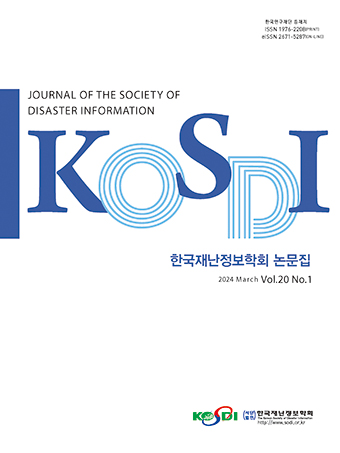Original Article
Abstract
References
Information
Purpose: Seismic safety evaluation of a curved bridge must be performed since the curved bridges exhibit the complex behavior rather than the straight bridges, due to geometrical characteristics. In order to conduct the probabilistic seismic assessment of the curved bridge, Seismic fragility evaluation was performed using the uncertainty of the steel material properties of a curved bridge girde, in this study. Method: The finite element (FE) model using ABAQUS platform of the curved bridge girder was constructed, and the statistical parameters of steel materials presented in previous studies were used. 100 steel material models were sampled using the Latin Hypercube Sampling method. As an input ground motion in this study, seismic fragility evaluation was performed by the normalized scale of the Gyeongju earthquake to 0.2g, 0.5g, 0.8g, 1.2g, and 1.5g. Result: As a result of the seismic fragility evaluation of the curved girder, it was found that there was no failure up to 0.03g corresponding to the limit state of allowable stress design, but the failure was started from 0.11g associated with using limit state design. Conclusion: In this study, seismic fragility evaluation was performed considering steel materials uncertainties. Further it must be considered the seismic fragility of the curved bridge using both the uncertainties of input motions and material properties.
연구목적: 곡선 교량은 기하하적 특성으로 직선교량에 비해 복잡한 거동을 보이기 때문에 지진 안전성 평가가 반드시 이루어져야 한다. 본 연구에서는 곡선 거더를 갖는 교량의 강재 재료 특성의 불확실성을 고려한 지진 취약도 평가를 수행하였다. 연구방법: I형 곡선 거더를 갖는 교량의 유한요소 모델을 구축하였으며 선행연구에서 제시된 강재 특성의 통계적 매개변수를 이용하였다. 라틴 하이퍼큐브 기법을 이용하여 100개의 강재 재료 모델을 샘플링하였다. 경주지진의 지반가속도를 0.2g, 0.5g, 0.8g, 1.2g, 1.5g로 scale을 변화시켜 지진 취약도 평가를 수행하였다. 연구결과: 곡선거더의 지진 취약도 평가결과 한계상태가 190MPa일 때 0.03g 파괴가 시작되었으며 한계상태가 315MPa일 때 0.11g를 초과하면서 파괴가 시작되는 것으로 나타났다. 결론: 본 연구에서는 재료 불확실성을 고려한 지진 취약도 평가를 수행하였으며 추후 연구에서는 지진파의 불확실성과 재료의 불확실성을 동시에 고려한 지진 취약도 분석이 필요할 것으로 판단된다.
- ABAQUS Ver. (2021). Dassault Systems.
- Bavaghar, Y., Bayat, M. (2017). "Seismic fragility curves for highly skewed highway bridges." Journal of Vibroengineering, Vol. 19, No. 4, pp. 2749-2758. 10.21595/jve.2017.18340
- Dong, J., Sause, R. (2010). "Finite element analysis of curved steel girder with tubular flange." Engineering Structures, Vol. 32, pp. 319-327. 10.1016/j.engstruct.2009.09.018
- Guo, J., Zhong, J., Dang, X., Yuan, W. (2019). "Influence of multidirectional cable restrainer on seismic fragility of a curved bridge." Journal of Bridge Engineering, Vol. 24, No. 3, pp. 1-13. 10.1061/(ASCE)BE.1943-5592.0001352
- Jeon, J., Ju, B.S., Son, H. (2018). "Seismic fragility analysis of curved beam with I-shape section." Journal of the Korea Society of Disaster Information, Vol. 14, No. 3, pp. 379-386.
- Jeon, J., Ju, B.S., Son, H. (2020). "Seismic fragility analysis of curved bridge under high frequency earthquakes." Journal of the Society of Disaster Information, Vol. 16, No. 6, pp. 806-812.
- Jeon, J.S., DesRoches, R., Kim, T., Choi, E. (2016). "Geometric parameters affecting seismic fragilities of curved multi-frame concrete box-girder bridges with integral abutments." Engineering Structures, Vol. 122, pp.121-143. 10.1016/j.engstruct.2016.04.037
- Jeon, J.S., Mangalathu, S., Song, J., Desroches, R. (2019). "Parameterized seismic fragility curves for curved multi-frame concrete box-girder bridges using bayesian parameter estimation." Journal of Earthquake Engineering, Vol. 23, No. 6, pp. 954-979. 10.1080/13632469.2017.1342291
- Kim, B.G., Sause, R. (2005). "High performance steel girders with tubular flanges." International Journal of Steel Structure, Vol. 5, No. 3, pp. 253-263.
- Kim, J.R., Kim, S.B., Park, Y.H., Jung, W.G. (2000). "A statistical study on the mechanical properties and chemical components of rolled steels for welded structure, SM490." Journal of the Architectural Institute of Korea Structure & Construction, Vol. 16, No. 11, pp. 3-10.
- Lee, W.H., Jeon, J.T. (1993). "A study on the torsional constant ratio of continuous curved girder bridges by transfer matrix method." Magazine and Journal of Korean Society of Steel Construction, Vol. 5, pp. 169-180.
- Oh, S.H., Shin, S.H. (2016). "Correlation analysis of gyeongju earthquake waveform and structural damage scale." Journal of the Architectural Institute of Korea: Structure & Construction, Vol. 32, No, 12, pp. 33-44. 10.5659/JAIK_SC.2016.32.12.33
- Ministry of Land, Transport and Maritime Affairs (2010). Korean Highway Bridge Design Code.
- Ministry of Land, Transport and Maritime Affairs (2012). Korean Highway Bridge Design Code.
- Seo, J., Park, H. (2017). "Probabilistic seismic restoration cost estimation for transportation infrastructure portfolios with an emphasis on curved steel I-girder bridges." Structural Safety, Vol. 65, pp. 27-34. 10.1016/j.strusafe.2016.12.002
- Wieser, J.D., Maragakis, E.M., Buckle, I.G. (2014). "Experimental evaluation of seismic performance of seat-type abutments in a curved highway bridge." Proceedings of the Tenth National Conference in Earthquake Engineering, Anchorage, Alaska, USA, pp. 1-11.
- Publisher :The Korean Society of Disaster Information
- Publisher(Ko) :한국재난정보학회
- Journal Title :Journal of the Society of Disaster Information
- Journal Title(Ko) :한국재난정보학회논문집
- Volume : 17
- No :4
- Pages :747-754
- DOI :https://doi.org/10.15683/kosdi.2021.12.31.747




 Journal of the Society of Disaster Information
Journal of the Society of Disaster Information







